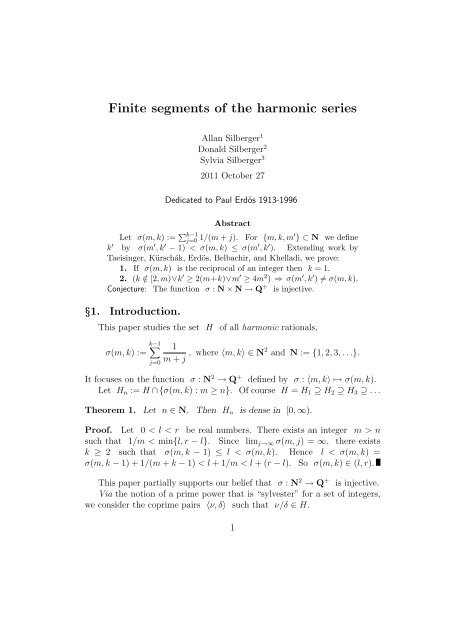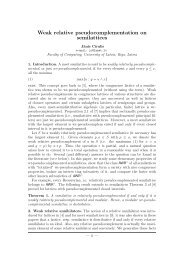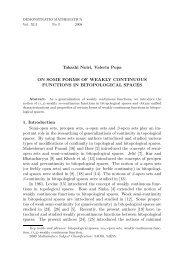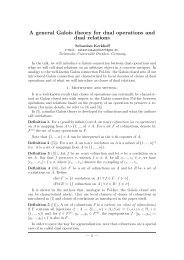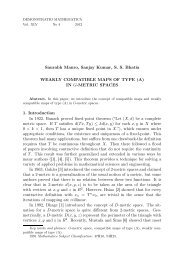Finite segments of the harmonic series
Finite segments of the harmonic series
Finite segments of the harmonic series
Create successful ePaper yourself
Turn your PDF publications into a flip-book with our unique Google optimized e-Paper software.
<strong>Finite</strong> <strong>segments</strong> <strong>of</strong> <strong>the</strong> <strong>harmonic</strong> <strong>series</strong><br />
Allan Silberger 1<br />
Donald Silberger 2<br />
Sylvia Silberger 3<br />
2011 October 27<br />
Dedicated to Paul Erdös 1913-1996<br />
Abstract<br />
Let σ(m, k) := k−1<br />
j=0 1/(m + j). For {m, k, m′ } ⊂ N we define<br />
k ′ by σ(m ′ , k ′ − 1) < σ(m, k) ≤ σ(m ′ , k ′ ). Extending work by<br />
Taeisinger, Kürschák, Erdös, Belbachir, and Khelladi, we prove:<br />
1. If σ(m, k) is <strong>the</strong> reciprocal <strong>of</strong> an integer <strong>the</strong>n k = 1.<br />
2. (k /∈ [2, m)∨k ′ ≥ 2(m+k)∨m ′ ≥ 4m 2 ) ⇒ σ(m ′ , k ′ ) = σ(m, k).<br />
Conjecture: The function σ : N × N → Q + is injective.<br />
§1. Introduction.<br />
This paper studies <strong>the</strong> set H <strong>of</strong> all <strong>harmonic</strong> rationals,<br />
σ(m, k) :=<br />
k−1 1<br />
j=0 m + j , where 〈m, k〉 ∈ N2 and N := {1, 2, 3, . . .}.<br />
It focuses on <strong>the</strong> function σ : N 2 → Q + defined by σ : 〈m, k〉 ↦→ σ(m, k).<br />
Let Hn := H ∩ {σ(m, k) : m ≥ n}. Of course H = H1 ⊇ H2 ⊇ H3 ⊇ . . .<br />
Theorem 1. Let n ∈ N. Then Hn is dense in [0, ∞).<br />
Pro<strong>of</strong>. Let 0 < l < r be real numbers. There exists an integer m > n<br />
such that 1/m < min{l, r − l}. Since limj→∞ σ(m, j) = ∞, <strong>the</strong>re exists<br />
k ≥ 2 such that σ(m, k − 1) ≤ l < σ(m, k). Hence l < σ(m, k) =<br />
σ(m, k − 1) + 1/(m + k − 1) < l + 1/m < l + (r − l). So σ(m, k) ∈ (l, r).<br />
This paper partially supports our belief that σ : N 2 → Q + is injective.<br />
Via <strong>the</strong> notion <strong>of</strong> a prime power that is “sylvester” for a set <strong>of</strong> integers,<br />
we consider <strong>the</strong> coprime pairs 〈ν, δ〉 such that ν/δ ∈ H.<br />
1
In 1915, L. Taeisinger proved that σ(1, k) ∈ N only if k = 1. In 1918,<br />
J. Kürschák showed that σ(m, k) is an integer only if m = k = 1. P.<br />
Erdös, [1932E] and Page 157 in [1998H], extended Kürschák’s <strong>the</strong>orem to<br />
finite arithmetic sub<strong>series</strong> <strong>of</strong> <strong>the</strong> <strong>harmonic</strong> <strong>series</strong>:<br />
k−1 1<br />
j=0 m + dj<br />
∈ N if (m, d) = 1 .<br />
H. Belbachir and A. Khelladi [2007BK] generalized <strong>the</strong> Erdös result thus:<br />
For α0, α1, . . . , αk−1 any positive integers,<br />
k−1<br />
<br />
j=0<br />
1<br />
(m + dj) αj<br />
∈ N if (m, d) = 1 .<br />
Let 1/N := {1/n : n ∈ N}. We will prove: σ(m, k) ∈ 1/N ⇒ k = 1.<br />
We will write x ≈ y to assert that |x − y| is small enough not to<br />
invalidate size relationships based upon our approximation to x = y.<br />
§2. Sylvester powers.<br />
For S a finite nonempty set <strong>of</strong> positive integers, σ(S) := <br />
j∈S 1/j, and<br />
µ(S) := <strong>the</strong> least common multiple <strong>of</strong> <strong>the</strong> elements in S. Observe that<br />
σ(S) = σ(S)µ(S)<br />
µ(S)<br />
ν(S)<br />
= , and that {σ(S)µ(S), µ(S)} ⊂ N, where<br />
δ(S)<br />
〈ν(S), δ(S)〉 is a uniquely determined coprime pair <strong>of</strong> positive integers.<br />
Our interest lies in <strong>the</strong> intervals [m, m + k) := {m, m + 1, . . . , m + k − 1}<br />
<strong>of</strong> consecutive positive integers. We write σ([m, m + k)), µ([m, m + k)),<br />
etc. simply as σ(m, k), µ(m, k), etc.; indeed we may simplify fur<strong>the</strong>r by<br />
writing instead σ, µ, and so forth when m and k are understood.<br />
We evoke two classic results:<br />
Bertrand’s Postulate/Chebyshev’s Theorem. (See Erdös [1934E]) If<br />
2 ≤ n ∈ N <strong>the</strong>n <strong>the</strong>re is a prime p ∈ (n, 2n).<br />
Sylvester’s Theorem. ([1892S] and [1934E]) If m > k <strong>the</strong>n p|µ for<br />
some prime p > k.<br />
2
One writes x n y in order to state that both x n |y and ¬ x n+1 |y.<br />
Definition. If X ⊆ N, if p is a prime, and if v ∈ N, <strong>the</strong>n we call p v<br />
sylvester for X iff p v µ(X) while p v |s for exactly one element s ∈ X.<br />
S(X) := {p v : p v is sylvester for X}, and S(m, k) := S([m, m + k)).<br />
Lemma 2. (Noted also in [2007BK]) Let <strong>the</strong> prime power p v be sylvester<br />
for a finite nonempty set F ⊆ N. Then p v δ(F ).<br />
Pro<strong>of</strong>. Let xp be <strong>the</strong> unique element in F with p v xp. Among <strong>the</strong> |F |<br />
distinct integers µ(F )/x whose sum is µ(F )σ(F ), only µ(F )/xp fails to<br />
be a multiple <strong>of</strong> p. So p is not a factor <strong>of</strong> <strong>the</strong> integer µ(F )σ(F ). Thus<br />
p v δ(F ), since p v µ(F ) and since µ(F )σ(F )/µ(F ) = ν(F )/δ(F ).<br />
Lemma 3. For each 〈m, k〉 with k ≥ 2, <strong>the</strong>re is a 2 v that is sylvester<br />
for [m, m + k). Indeed k/2 < 2 v < m + k.<br />
Pro<strong>of</strong>. Since k ≥ 2 we have that 2 v µ(m, k) for some v ≥ 1. Let s<br />
be <strong>the</strong> smallest multiple <strong>of</strong> 2 v in [m, m + k). Plainly s = 2 v a for some<br />
odd integer a. Then b := 2 v a + 2 v is <strong>the</strong> smallest multiple <strong>of</strong> 2 v with<br />
b > s. Since b = 2 v (a + 1), and since <strong>the</strong> integer a + 1 is even, we have<br />
that 2 v+1 |b. Hence b ≥ m + k since ¬ 2 v+1 |µ(m, k). Thus s is <strong>the</strong><br />
only multiple <strong>of</strong> 2 v in [m, m + k). So 2 v is sylvester for [m, m + k).<br />
The first claim is established. The second claim follows from <strong>the</strong> facts that<br />
2 v+1 |µ(m, k) if 2 v ≤ k/2, and that 2 v < m + k since 2 v |µ(m, k).<br />
Corollary 4. If 〈m, k〉 = 〈1, 1〉 <strong>the</strong>n S(m, k) = ∅.<br />
Remark. If p > 2 is prime <strong>the</strong>n ¬ (p v µ(F ) ⇒ p v ∈ S(F )). E.g., 5 2 is<br />
not sylvester for [25, 51) := {25, 26, . . . , 50} although 5 2 µ(25, 26).<br />
Kürschák’s Theorem. ([1918K]) If σ(m, k) ∈ N <strong>the</strong>n m = k = 1.<br />
Pro<strong>of</strong>. Let 〈m, k〉 = 〈1, 1〉. Then Lemmas 2 and 3 imply that δ(m, k) is<br />
even. So ν(m, k)/δ(m, k) is not an integer.<br />
Corollary 5. If a/b ∈ H with (a, b) = 1 and with a > 1, <strong>the</strong>n 2|b.<br />
3
Corollary 6. Let a/b ∈ H with (a, b) = 1. Then <strong>the</strong>re is a pair 〈m, k〉<br />
such that b|µ(m, k), and such that µ(m, k)/b = σ(m, k)µ(m, k)/a.<br />
Pro<strong>of</strong>. There exists 〈m, k〉 ∈ N 2 for which 〈a, b〉 = 〈ν(m, k), δ(m, k)〉.<br />
But ν/δ is <strong>the</strong> lowest-terms form <strong>of</strong> <strong>the</strong> rational number σµ/µ. It follows<br />
that µ/b = q = σµ/a for some q ∈ N.<br />
Corollary 7. The integer µ/δ = σµ/ν is a product <strong>of</strong> powers p n <strong>of</strong> odd<br />
primes p ≤ k.<br />
The next result engenders our guess that σ : N 2 → Q + is injective.<br />
Theorem 8. If k ≥ 2 <strong>the</strong>n σ(m, k) ∈ 1/N.<br />
Pro<strong>of</strong>. Pretend <strong>the</strong> <strong>the</strong>orem fails for a given k ≥ 2 and m ≥ 1. That is,<br />
we pretend that σ = 1/δ.<br />
If kδ < m <strong>the</strong>n 1/kδ > 1/m > 1/(m+1) > · · · > 1/(m+k−1), whence<br />
1/δ = k · 1/kδ > 1/m + 1/(m + 1) + · · · + 1/(m + k − 1) =: σ. Similarly, if<br />
kδ > m + k − 1 <strong>the</strong>n 1/δ < σ. Hence m ≤ kδ ≤ m + k − 1 if σ = 1/δ.<br />
From k ≥ 2 we get 1/m < σ = 1/δ. Thus 2 ≤ δ < m. So<br />
kδ ≤ m + k − 1 implies k ≤ k(δ − 1) ≤ m − 1 < m, giving us m > k.<br />
Sylvester’s <strong>the</strong>orem implies that <strong>the</strong>re is a prime p > k and v ∈ N such<br />
that p v ∈ S(m, k). Then p v xp for exactly one xp ∈ [m, m + k), and<br />
(p, x) = 1 for every x ∈ [m, m + k) \ {xp}. Hence (µ/xp, p) = 1, while<br />
p|µ/x for each x ∈ [m, m + k) \ {xp}. So (µσ, p) = 1 while p v µ.<br />
Therefore p v δ, since µσ/µ = 1/δ. We must infer that xp = kδ.<br />
Define σ ′ := σ − 1/kδ = c/d with (c, d) = 1. Then σ ′ = 1/δ − 1/kδ =<br />
(k − 1)/kδ. Now p|kδ, but (k − 1, p) = 1 since p > k. So p|d. On<br />
<strong>the</strong> o<strong>the</strong>r hand, σ ′ = (µσ − µ/kδ)/µ, and p v | (µσ − µ/kδ) since p v µ/x<br />
for every x ∈ [m, m + k) \ {kδ}. Thus, recalling that p v µ we infer that<br />
(p, d) = 1, reaching a contradiction: p|d ∧ (p, d) = 1. So σ = 1/δ.<br />
Notice that Theorem 8 implies that Hn ⊃ Hn+1 for all n ∈ N.<br />
Henceforth fix 〈m, k, m ′ 〉 ∈ N 3 with k ≥ 2 and m ′ ≥ m + k; define<br />
k ′ = min{j : σ(m ′ , j) ≥ σ(m, k)}. Observe that 0 ≤ σ(m ′ , k ′ ) − σ(m, k) <<br />
σ(m ′ , k ′ ) − σ(m ′ , k ′ − 1) = 1/(m ′ + k ′ − 1) ≤ 1/(m + 2k).<br />
Theorem 9. Let m ′ ≤ k ′ . Then σ(m ′ , k ′ ) = σ(m, k).<br />
4
Pro<strong>of</strong>. Since 2m ′ ≤ m ′ + k ′ , by Bertrand’s Postulate <strong>the</strong>re is a largest<br />
prime p with m ′ ≤ (m ′ +k ′ )/2 < p < m ′ +k ′ , and 2p ∈ [m ′ , m ′ +k ′ ). Surely<br />
p 1 is sylvester for [m ′ , m ′ +k ′ ), whence p|δ(m ′ , k ′ ) by Lemma 2. But p > i<br />
for every i ∈ [1, m ′ − 1]. Thus, ¬ p|j for all j ∈ [m, m + k) ⊆ [1, m ′ − 1],<br />
and so ¬ p|µ(m, k) whence ¬ p|δ(m, k). Therefore σ(m, k) = σ(m ′ , k ′ ).<br />
The following lemma utilizes a tightening <strong>of</strong> <strong>the</strong> fact that<br />
m+k−1<br />
σ(m, k) ≈<br />
m<br />
dx<br />
x<br />
= ln(1 + k − 1<br />
m ).<br />
Lemma 10. Let k ≥ 2. Then 1 + k/m ≤ m ′ /m < (k ′ − 1)/(k − 1).<br />
Pro<strong>of</strong>. We can view σ(m, k) as a step function above 1/x, and note that<br />
σ(m, k − 1) > ln(1 +<br />
k − 1<br />
m ).<br />
Therefore, since σ(m, k) = σ(m, k − 1) + 1/(m + k − 1), we infer that<br />
1<br />
m + k − 1<br />
< σ(m, k) − ln(1 + k − 1<br />
m ).<br />
Next, viewing σ(m + 1, k − 1) as a step function under 1/x, we see that<br />
σ(m + 1, k − 1) < ln(1 +<br />
k − 1<br />
m )<br />
and hence, since σ(m, k) = σ(m + 1, k − 1) + 1/m, we infer that<br />
σ(m, k) − ln(1 +<br />
Combining inequalities, we get that<br />
1<br />
m + k − 1<br />
Similarly we infer that<br />
k − 1 1<br />
) <<br />
m m .<br />
k − 1 1<br />
< σ(m, k) − ln(1 + ) <<br />
m m .<br />
− 1<br />
m ′ < ln(1 + k′ − 1<br />
m ′ ) − σ(m ′ , k ′ 1<br />
) < −<br />
m ′ + k ′ − 1 .<br />
5
From <strong>the</strong> immediately preceding two sets <strong>of</strong> inequalities we get that<br />
1 1<br />
−<br />
m + k − 1 m ′ < ln(1 + k′ − 1<br />
m ′ k − 1<br />
)/(1 +<br />
m ) + σ − σ′ ,<br />
where σ and σ ′ are shorthand for σ(m, k) and σ(m ′ , k ′ ), respectively.<br />
Recall that σ − σ ′ ≤ 0. Since m + k ≤ m ′ , we have that<br />
Therefore<br />
0 < L :=<br />
The lemma follows.<br />
1 1<br />
−<br />
m + k − 1 m ′ < ln(1 + k′ − 1<br />
m ′ )/(1 +<br />
1 < e L < (1 + k′ − 1<br />
m ′ )/(1 +<br />
1 + k′ − 1<br />
m ′<br />
k − 1<br />
) , whence<br />
m<br />
k − 1<br />
> 1 +<br />
m .<br />
Theorem 11. Let m < k. Then σ(m, k) = σ(m ′ , k ′ ).<br />
k − 1<br />
) .<br />
m<br />
Pro<strong>of</strong>. Lemma 10 gives us that 1 ≤ (k−1)/m < (k ′ −1)/m ′ . So m ′ < k ′ −1<br />
whence σ(m, k) = σ(m ′ , k ′ ) by Theorem 9.<br />
Corollary 12. Let σ > 1/m + ln 2. Then σ ′ = σ.<br />
Pro<strong>of</strong>. In our pro<strong>of</strong> <strong>of</strong> Lemma 10 we saw that σ < 1/m+ln(1+(k −1)/m).<br />
So 1/m + ln 2 < σ < 1/m + ln(1 + (k − 1)/m) by hypo<strong>the</strong>sis. It follows that<br />
ln 2 < ln(1 + (k − 1)/m). Thus m < k − 1. So σ ′ = σ by Theorem 11.<br />
Given 〈m, k, m ′ 〉 ∈ N 3 , recall that k ′ is determined, and that if<br />
σ(m ′ , j) = σ(m, k) <strong>the</strong>n j = k ′ . By Theorem 11, σ(m ′ , k ′ ) = σ(m, k)<br />
when <strong>the</strong> interval [m, m + k) is “long”; i.e., when m < k. Theorem 8<br />
implies that for no m is <strong>the</strong>re a 〈m ′ , k ′ 〉 such that σ(m ′ , k ′ ) = σ(m, 1).<br />
We have not established <strong>the</strong> injectivity <strong>of</strong> σ for 2 ≤ k ≤ m. But we<br />
now show that, for each m, <strong>the</strong>re are at most finitely many m ′ > m for<br />
which <strong>the</strong> possibility σ(m ′ , k ′ ) = σ(m, k) will not yet have been eliminated.<br />
Theorem 13. Let k ′ ≥ 2(m + k). Then σ(m ′ , k ′ ) = σ(m, k).<br />
6
Pro<strong>of</strong>. By Lemma 3, 2 v ∈ S(m, k) for some v ∈ N. But 2 v ∈ S(m ′ , k ′ )<br />
since 2 v+1 |µ(m ′ , k ′ ). So 2 v+1 |δ(m ′ , k ′ ) by Lemma 2, while 2 v δ(m, k).<br />
Since <strong>the</strong> fractions ν(m, k)/δ(m, k) and ν(m ′ , k ′ )/δ(m ′ , k ′ ) are in lowest<br />
terms, we have that σ(m ′ , k ′ ) = σ(m, k).<br />
Given m and k, clearly <strong>the</strong> integers m ′ and k ′ determine each o<strong>the</strong>r.<br />
For 2 ≤ k < m this implies that k ′ < 2(m+k) ⇒ m ′ < 4m 2 . In summary,<br />
σ(m ′ , k ′ ) = σ(m, k) remains unprecluded by Theorems 8, 11, and 13 only<br />
when all three <strong>of</strong> <strong>the</strong> following conditions obtain: m ≥ 3 and 2 ≤ k < m<br />
and k ′ < 2(m + k). Note that m ′ /m ≈ k ′ /k, with k ′ ≥ m ′ k/m > k ′ − 1.<br />
Thus, to prove σ injective, we need depose for each m ≥ 3 fewer than<br />
m 2 + m possible counterexamples.<br />
We have shown that S(X) = S(Y ) ⇒ σ(X) = σ(Y ), But regretably<br />
¬ [S([x, y)) = S([w, z)) ⇒ [x, y) = [w, z)]. For example, S({5, 6, 7}) =<br />
{2, 3, 5, 7} = S({14, 15}). But S({14, 15, 16}) = {2 4 , 3, 5, 7} = S({5, 6, 7}).<br />
Indeed, S({5, 6, 7}) = S([14, 14 + k)) for every k ≥ 3.<br />
Echoing Sylvester, upon its verification <strong>the</strong> following narrowly germane<br />
guess would immediately establish that σ : N 2 → Q + is injective.<br />
Conjecture. If m + 2 ≤ m + k ≤ m ′ <strong>the</strong>n S(m ′ , k ′ ) = S(m, k).<br />
Definition. We call a family D <strong>of</strong> finite subsets <strong>of</strong> N distinguished iff<br />
when X = Y are elements in D <strong>the</strong>n S(X \ Y ) = S(Y \ X).<br />
From our work thus far, <strong>the</strong> following two <strong>the</strong>orems are easy exercises.<br />
Theorem 14. If D is distinguished <strong>the</strong>n σ : D → Q + is injective.<br />
We do not allege <strong>the</strong> converse <strong>of</strong> Theorem 14.<br />
When B ⊂ N and n ∈ N, let B n := {j n : j ∈ B}. And, for D a<br />
family <strong>of</strong> finite nonempty subsets <strong>of</strong> N, let D (n) := {B n : B ∈ D}.<br />
Theorem 15. A family D <strong>of</strong> finite nonempty subsets <strong>of</strong> N is distinguished<br />
if and only if D (n) is distinguished for every n ∈ N. Hence, if D is<br />
distinguished <strong>the</strong>n σ|`D (n) is injective for every n.<br />
7
Problem. Identify <strong>the</strong> maximal distinguished subfamilies <strong>of</strong> <strong>the</strong> collection<br />
P(N) <strong>of</strong> all subsets <strong>of</strong> N?<br />
Acknowledgments<br />
Arthur Tuminaro inspired us to begin this work, and it was enlightened<br />
by conversations with Jacqueline Grace and David Hobby.<br />
References<br />
[1892S] J. J. Sylvester, On arithmetical <strong>series</strong>. Messinger <strong>of</strong> Ma<strong>the</strong>matics,<br />
XXI (1892), 1-19, 87-120, and Ma<strong>the</strong>matical Papers 4(1912), 687-731.<br />
[1932E] P. Erdös, Verallgemeinerung eines elementar-zahlenteoretischen<br />
Satzes von Kürschák. Mat. Fiz. Lapok 39(1932), 17-24.<br />
[1934E] P. Erdös, A <strong>the</strong>orem <strong>of</strong> Sylvester and Schur. J. London Math. Soc.<br />
9(1934), 282-288.<br />
[1998H] P. H<strong>of</strong>fman, “The man who loved only numbers: The story <strong>of</strong> Paul<br />
Erdös and <strong>the</strong> search for ma<strong>the</strong>matical truth.” N. Y. Hyperion. 1998.<br />
[2007BK] H. Belbachir and A. Khelladi, On a sum involving powers <strong>of</strong><br />
reciprocals <strong>of</strong> an arithmetic progression. Ann. Ma<strong>the</strong>maticae et Informaticae<br />
34(2007), 29-31. http://www.ektf.hu/tanszek/matematika/ami<br />
Addresses<br />
1 Cleveland State University, Cleveland OH 44115<br />
a.silberger@csuohio.edu<br />
2 State University <strong>of</strong> New York at New Paltz NY 12561<br />
SilbergD@lan.newpaltz.edu or preferably DonSilberger@hvc.rr.com<br />
3 H<strong>of</strong>stra University, Hempstead NY 11549<br />
matsbs@h<strong>of</strong>stra.edu<br />
MSC2010: 11A41, 11B75, 11B99<br />
8


